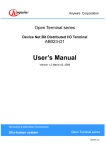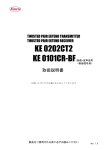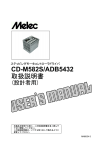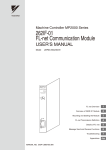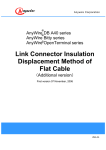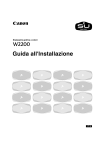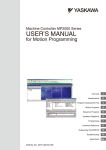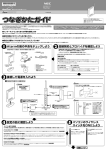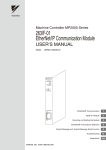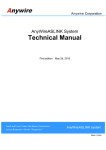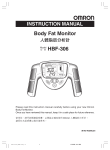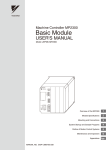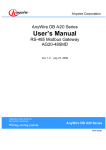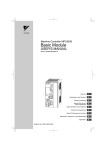Download User`s Manual
Transcript
Anywire Corporation Open Terminal series MECHATROLINK Bit Distributed I/O Terminal AB023-M1 User’s Manual Version 1.0 June 23, 2005 Bit Control & Information Transmission Sho-haisen system Open Terminal series ab023m1uma Precautions Precautions for this manual 1. 2. 3. 4. 5. Please deliver this User’s Manual to the end user. Please read this User’s Manual carefully and understand the details of the product well before you start using it. This manual explains the details of the functions including in the product, but does not guarantee the compatibility to user’s own purpose. It is prohibited to reprint or reproduce a part of this manual or all without permission. The contents of this manual may be changed without notice. The indications of warnings and cautions for safe and correct use Indicates a potentially hazardous situation, which, if not avoided, could result in death or serious injury. Indicates a potentially hazardous situation, which, if not avoided, could cause personal injury or damage. The precautions for using the system under safety condition ◆ AnyWire System is not intended to have control functions for securing safety. ◆ In the following cases, special consideration is necessary for the usage sufficient for ratings and functions, and necessary for safeguard such as fail-safe function. And also, please contact our company. (1) ications requiring higher safety 1- Applications expected to have a great influence on life or property 1- Medical equipment, or safety devices (2) ications requiring higher reliability of system 1- Applications for vehicle control or burning control system ◆Be sure to turn the power off before installation or replacement. ◆ Be sure to use AnyWire System within the specifications and conditions prescribed in this manual. i ◆ Be sure not to turn on the 24V power before completing wiring and connecting in AnyWire System. ◆ Use a regulated power supply of 24V DC. Non-regulated power supply may cause a trouble to the system. ◆ Keep transmission cables and I/O cables away from high-voltage and power cables, though the AnyWire System has high noise margin. ◆ Be careful not to allow metal bits into the unit, the connectors or the terminal blocks, especially when wiring. ◆ Mis-wiring may cause failure. Consider the length and installation of cable wiring to keep connectors and cables from disconnecting or excessive distortion. ◆ Never solder the stranded wire to be connected with the terminal block, otherwise causing a defective contact. ◆ In case of long cable length of power line along the transmission lines, large voltage drops will occur and may cause voltage shortage for the distant Slave Units. In that circumstance, connect the local power supply units so that the prescribed voltage is secured at each local Slave Unit. ◆ Be careful of the following items about installation environment. · No exposing directly to the sunlight and ambient temperature is 0 to +55 ˚C. · Operating relative humidity is 10 to 90 % and no dew condensation by sudden temperature change · No corrosive or inflammable gases · No direct vibration or impact ◆ Fasten terminal screws securely to avoid malfunction. ◆ In case of storage of the product, keep away from high temperature and high humidity. (Storage temperature is –20 to 75˚C.) ◆ When the emergency stop circuit or the interlock circuit for safety are arranged, provide these circuits outside the AnyWire System. ii INDEX 1 OUTLINE ................................................................ ................................................................................................ ................................................................................................ ........................................................................................... ........................................................... 1-1 2 SPECIFICATION ................................................................ ................................................................................................ ................................................................................................ .......................................................................... ..........................................2 .......... 2-1 3 2.1. GENERAL SPECIFICATIONS............................................................................................................................................ 2-1 2.2. CAPABILITY SPECIFICATIONS ....................................................................................................................................... 2-1 2.3. DIMENSION ........................................................................................................................................................................... 2-3 2.4. NAME OF EACH PART ...................................................................................................................................................... 2-4 2.5. DETACHING TO DIN RAIL ............................................................................................................................................... 2-5 SWITCH SETTING ................................................................ ................................................................................................ ................................................................................................ ...................................................................... ......................................3 ...... 3-1 3.1. 4 3.1.1. Operating mode setting (MODE) .....................................................................................................................................................3-1 3.1.2. The station number setting (Station №)......................................................................................................................................3-1 REGISTER ALLOCATION................................ ................................................................ ................................................................................................ ....................................................................................... .......................................................4 ....................... 4-1 4.1. 17byte mode .............................................................................................................................................................................................4-1 4.1.2. 32byte mode .............................................................................................................................................................................................4-2 4.1.3. Alarm ............................................................................................................................................................................................................4-3 4.1.4. Status ..........................................................................................................................................................................................................4-3 4.1.5. Slave response alarm reset output ................................................................................................................................................4-3 7 8 iii MODULE DEFINITION ......................................................................................................................................................... 5-1 5.1.1. Parameter setting...................................................................................................................................................................................5-2 5.1.2. Link allocation ..........................................................................................................................................................................................5-3 5.1.3. I/O Map.......................................................................................................................................................................................................5-5 5.1.4. Status ..........................................................................................................................................................................................................5-6 5.1.5. MECHATROLINK Saving Defined Data ........................................................................................................................................5-6 5.1.6. I/O register allocation example........................................................................................................................................................5-7 MONITORING FUNCTION................................ ................................................................ ................................................................................................ ....................................................................................... .......................................................6 ....................... 6-1 6.1. AUTOMATIC ADDRESS RECOGNITION........................................................................................................................ 6-1 6.2. MONITORING OPERATION ............................................................................................................................................... 6-1 LED INDICATION ................................................................ ................................................................................................ ................................................................................................ ........................................................................ ........................................7 ........ 7-1 7.1. MECHATROLINK SIDE ................................................................................................................................................ 7-1 7.2. SHO-HAISEN BUS SIDE .................................................................................................................................................... 7-1 CONNECTIONS ................................................................ ................................................................................................ ................................................................................................ ........................................................................... ...........................................8 ........... 8-3 8.1. 9 DATA FORMAT .................................................................................................................................................................... 4-4 SETTING FROM THE PROGRAMMING TOOL ................................................................ ............................................................................. .............................................5 ............. 5-1 5.1. 6 MP2000 SERIES................................................................................................................................................................. 4-1 4.1.1. 4.2. 5 MECHATROLINK SIDE ................................................................................................................................................ 3-1 TERMINATOR ....................................................................................................................................................................... 8-4 TIME REQUIRED FOR TRANSMISSION................................ ................................................................ ............................................................................................ ............................................................ 9-1 9.1. INPUT .........................................................................................................................................................................................9-1 9.2. OUTPUT ....................................................................................................................................................................................9-1 10 TROUBLE SHOOTING ................................................................ ................................................................................................ ...................................................................................... ...................................................... 10- 10-1 10.1. MECHATROLINK SIDE .........................................................................................................................................10-1 10.2. SHO-HAISEN BUS SIDE ..................................................................................................................................................10-1 11 CHANGE HISTORY ................................................................ ................................................................................................ ............................................................................................ ............................................................ 11- 11-1 iv 1 Outline Bit decentralization I/O terminal is the best for MECHATROLINK when I/O under the Link controlling more distribution in detail. The I/O signal and the power supply can be sent to the terminal (D-I/O terminal) in two wires transmission lines. Even if the divergence of wiring is done, the disconnection detection is possible. The maximum input 256 points and the output 256 points a unit of AB023-M1 can be capable for input and output operation. (The number of I/O points per one system of AB023-M1 <Bit distributed I/O terminal/bus copular> NOTE) Note) MECHATROLINK is the registered trademark of YASKAWA Electric Corporation in Japan. AB023-M1 Slave input unit ・・ Sho-haisen Bus Output slave unit Slave input unit Output slave unit ・・ 1-1 2 Specification 2.1. General Specifications Ambient operating 0℃ ... +55℃ Temperature Storage - 20℃ ... +75℃ Temperature Storage Humidity Ambient Atmosphere 2.2. 10% ... 90%RH (No condensation) No corrosive or flammable gas Capability Specifications System Specifications on Sho-haisen Bus side Transmission Clock 28.7 KHz Transmission Mode Total frame cyclic method with DC power supply on common wire Connection Form Bus Form (A Multi-drop Method, a T-branch Method, a Tree Branch Method) Transmission Protocol Special protocol(AnyWire Bus-e protocol) Number of Connection 432 points (IN: 216 points OUT: 216 points) or 192 points (IN: 96 points OUT: I/O points Number of the 96 points) Up to 128 units (Changed by consumption current of each unit) connection points Transmission Cycle Time 5.5ms/IO 192 points 10.2ms/IO432 points Note) The transmission cycle time reaches the value between 1 to 2 cycle times. (1 cycle time value) Connection Cable Maximum Transmission Distance Supply Maximum General-purpose 2-wire cable (0.75 mm² ... 2.0 mm²) During operation of rated 24 V: 50m(1.25 mm² electric cable) Condition: 2 A load current, a relay drive ability distance 2A Current of transmission Power supply voltage Range of voltage during DC26.4V (24-VDC rated supply) Power source supply is unnecessary. (supplied from the transmission line) use slaves Supply voltage of slave load 2-1 Power source supply is unnecessary. (supplied from the transmission line) System Specification on MECHATROLINK side (when connected to the MP2000 series machine controller made by YASUKAWA Electric Corp.) MECHATROLINK-Ⅰ Version MECHATROLINK-Ⅱ Transmission Method Bus Bus Maximum Transmission 50 m 50 m 0.5 m 0.5 m 4Mbps 10Mbps Communication Cycle 2ms 1ms, 1.5 ms or 2 ms Number of Maximum 14 stations 21 stations Cyclic Method Cyclic Method Distance Minimum Station Distance Transmission Speed Connection stations Transmission Control Method - This unit can be used with the products of the versions shown below or later. Programming device software MPE720: V5.32 MP2000 Series machine controller CPU: V2.42 MECHATROLINK interface module SVB-01: V1.15 - This unit uses intelligent I/O. - MECHATROLINK-I (17-byte mode), MECHATROLINK-II (17-byte mode), and MECHATROLINK-II (32-byte mode) are supported. - The unit supports asynchronous communication, but not synchronous communication. - The 0.5-ms communication cycle is not supported. - It takes about 30 ms before the data input from this unit or the data output from the slave unit is updated after the status of the MP2000 Series CPU is changed from STOP to RUN. Data before the update is treated as "off" data. 2-2 2.3. Dimension (*印寸法はカバー開放時の寸法) * is a size when opened the cover. ****印寸法はDINレール搭載時の寸法 is a size when installed the CIN rail. (** is a size when(**はDINレール搭載時の寸法) installed the CIN rail.) 2-3 2.4. Name of Each Part MECHATROLINK接続コネクタ MODE設定 スイッチ Station No. 設定スイッチ モニタ接続 ポート SETスイッチ 表示LED Bitty接続端子 Japanese English MECHATROLINK接続コネクタ MECHATROLINK Connection Connector MODE設定スイッチ MODE setting switch モニタ接続ポート Monitor Connection Port Station No. 設定スイッチ Station No. setting switch SETスイッチ SET Switch 表示LED Indication LED 2-4 2.5. Detaching to DIN Rail Please use and install this unit on the DIN. 1. How to install this unit on DIN rail [1] A fixed pick upper in the bottom is put on the DIN rail. [2] This device is pressed against the DIN rail and sets it. Install 取り付け 2. How to detach this unit from DIN rail The hook comes off from the rail when a minus driver is defeated to the difference all-in in the hook and the driver is defeated to this device side. The main body fixation pick side is detached, and under such a condition, please lift and detach the main body hook side to the starting point. [2] ② [2] ② Detach 取り外し [1]① 2-5 [1] ① 3 Switch Setting 3.1. MECHATROLINK side 3.1.1. Operating mode setting (MODE) Indication Name Status Function Setting at shipping Communication ON MECHATROLINK-II (10Mbps) ON speed setting OFF MECHATROLINK-I (4Mbps) I/O byte setting ON 32byte mode OFF 17byte mode MECHATROLINK ON 7xh Upper address OFF 6xh - Use at OFF Name 1 2 3 OFF OFF setting 4 System reserved OFF 432 points at 32byte-mode transmission (IN: 216 points, OUT: 216 points) 192 points at 17byte-mode transmission (IN: 96 points, OUT: 96 points) For MECHATROLINK-I, a baud rate of 4 Mbps and the 17-byte mode are used. 3.1.2. The station number setting (Station №) Set the station number of MECHATROLINK-I. When connecting more than one unit, take care to avoid station number overlap. Station numbers from 61H to 7EH can be set using the Station number switch in combination with the MODE switch 3. For the MP2000 Series machine controller made by YASUKAWA Electric Corp., however, the maximum station number must be as shown in the table below. Communication Transmission Communication Number of slave Maximum Method Speed Cycle stations Station No. MECHATROLINK-I 4Mbps 2 ms 14 stations 6EH MECHATROLINK-II 10Mbps 1 ms 15 stations 6FH 1 ms 9 stations 69H 1.5ms 15 stations 6FH 2 ms 21 stations 75H (17byte mode) MECHATROLINK-II (32byte mode) 10Mbps 3-1 The station number setting list ST# (station No.) Switch Setting MODE Switch “3” Station No. Switch 01 (61H) OFF 1 02 (62H) OFF 2 03 (63H) OFF 3 04 (64H) OFF 4 05 (65H) OFF 5 06 (66H) OFF 6 07 (67H) OFF 7 08 (68H) OFF 8 09 (69H) OFF 9 10 (6AH) OFF A 11 (6BH) OFF B 12(6CH) OFF C 13 (6DH) OFF D 14 (6EH) OFF E 15 (6FH) OFF F 16 (70H) ON 0 17 (71H) ON 1 18 (72H) ON 2 19 (73H) ON 3 20 (74H) ON 4 21 (75H) ON 5 Values 01 to 21 are the station numbers that are displayed in the Link Allocation window and other windows of the programming device software MPE720. - The 0.5-ms communication cycle is not supported. - Communication cannot be performed when station number 60H is set. - Before setting the DIP switches, be sure to turn off the power. - Set the DIP switches according to the transmission specifications in use. - If the transmission specifications of this unit do not match those of the connected slave unit, data may not be transmitted normally, possibly causing a malfunction. 3-2 4 4.1. Register allocation MP2000 series This section describes the register allocation pattern to be used when the MP2000 series machine controller made by YASUKAWA Electric Corporation is used as the master unit. 4.1.1. 17byte mode In the 17-byte mode, 96 points of input and 96 points of output can be transmitted. Input Input Register 15 14 13 12 11 10 9 8 7 6 5 4 3 IWxxxx Alarm System Usage IWxxxx+1 Status High Status Low 2 1 0 IWxxxx+2 15 14 13 12 11 10 9 8 7 6 5 4 3 2 1 0 IWxxxx+3 31 30 29 28 27 26 25 24 23 22 21 20 19 18 17 16 IWxxxx+4 47 46 45 44 43 42 41 40 39 38 37 36 35 34 33 32 IWxxxx+5 63 62 61 60 59 58 57 56 55 54 53 52 51 50 49 48 IWxxxx+6 79 78 77 76 75 74 73 72 71 70 69 68 67 66 65 64 IWxxxx+7 95 94 93 92 91 90 89 88 87 86 85 84 83 82 81 80 15 14 13 12 11 10 9 8 7 6 5 4 3 2 1 0 Output Output Register OWxxxx For option System reserved OWxxxx+1 For option *1 OWxxxx+2 15 14 13 12 11 10 9 8 7 6 5 4 3 2 1 0 OWxxxx+3 31 30 29 28 27 26 25 24 23 22 21 20 19 18 17 16 OWxxxx+4 47 46 45 44 43 42 41 40 39 38 37 36 35 34 33 32 OWxxxx+5 63 62 61 60 59 58 57 56 55 54 53 52 51 50 49 48 OWxxxx+6 79 78 77 76 75 74 73 72 71 70 69 68 67 66 65 64 OWxxxx+7 95 94 93 92 91 90 89 88 87 86 85 84 83 82 81 80 * Slave response alarm reset output 4-1 4.1.2. 32byte mode In the 32-byte mode, 216 points of input and 216 points of output can be transmitted. Input Input Register 15 14 13 12 IWxxxx 11 10 9 8 7 6 5 Alarm IWxxxx+1 4 3 2 1 0 System Used Status High Status Low IWxxxx+2 15 14 13 12 11 10 9 8 7 6 5 4 3 2 1 0 IWxxxx+3 31 30 29 28 27 26 25 24 23 22 21 20 19 18 17 16 IWxxxx+4 47 46 45 44 43 42 41 40 39 38 37 36 35 34 33 32 IWxxxx+5 63 62 61 60 59 58 57 56 55 54 53 52 51 50 49 48 IWxxxx+6 79 78 77 76 75 74 73 72 71 70 69 68 67 66 65 64 IWxxxx+7 95 94 93 92 91 90 89 88 87 86 85 84 83 82 81 80 IWxxxx+8 111 110 109 108 107 106 105 104 103 102 101 100 99 98 97 96 IWxxxx+9 127 126 125 124 123 122 121 120 119 118 117 116 115 114 113 112 IWxxxx+A 143 142 141 140 139 138 137 136 135 134 133 132 131 130 129 128 IWxxxx+B 159 158 157 156 155 154 153 152 151 150 149 148 147 146 145 144 IWxxxx+C 175 174 173 172 171 170 169 168 167 166 165 164 163 162 161 160 IWxxxx+D 191 190 189 188 187 186 185 184 183 182 181 180 179 178 177 176 IWxxxx+E 207 206 205 204 203 202 201 200 199 198 197 196 195 194 193 192 IWxxxx+F Not Used 215 214 213 212 211 210 209 208 Output Output 15 14 13 12 11 10 9 8 7 6 5 4 3 2 1 0 Register OWxxxx For Option System reserved OWxxxx+1 For option *1 OWxxxx+2 15 14 13 12 11 10 9 8 7 6 5 4 3 2 1 0 OWxxxx+3 31 30 29 28 27 26 25 24 23 22 21 20 19 18 17 16 OWxxxx+4 47 46 45 44 43 42 41 40 39 38 37 36 35 34 33 32 OWxxxx+5 63 62 61 60 59 58 57 56 55 54 53 52 51 50 49 48 OWxxxx+6 79 78 77 76 75 74 73 72 71 70 69 68 67 66 65 64 OWxxxx+7 95 94 93 92 91 90 89 88 87 86 85 84 83 82 81 80 OWxxxx+8 111 110 109 108 107 106 105 104 103 102 101 100 99 98 97 96 OWxxxx+9 127 126 125 124 123 122 121 120 119 118 117 116 115 114 113 112 OWxxxx+A 143 142 141 140 139 138 137 136 135 134 133 132 131 130 129 128 OWxxxx+B 159 158 157 156 155 154 153 152 151 150 149 148 147 146 145 144 OWxxxx+C 175 174 173 172 171 170 169 168 167 166 165 164 163 162 161 160 OWxxxx+D 191 190 189 188 187 186 185 184 183 182 181 180 179 178 177 176 OWxxxx+E 207 206 205 204 203 202 201 200 199 198 197 196 195 194 193 192 OWxxxx+F Not Used 215 214 213 212 211 210 209 208 *1 Slave response alarm reset output 4-2 4.1.3. Alarm The high-order bytes of IWxxxx contain alarm information. The code is represented in hexadecimal notation. Code 00 indicates the normal status. Codes 01 to 7F are for MECHATROLINK, and codes 80 and larger are for Sho-haisen bus. Alarm code (Hex) Factors 00 Normal 01 An unsupported command was received. A command inconsistent with the communication phase was received. 02 The command execution condition is not met. 4.1.4. 03 The data in the command is invalid. 80 Short circuit between Sho-haisen bus DP and DN 81 Slave response alarm (transmission line cut, slave failure, etc.) Status IWxxxx+1 contain status information. This unit does not use a warning bit. Bit Name B0 Alarm bit B1 B2 B3 ... 15 Factors 0 No alarm 1 Alarm Warning 0 No warning bit 1 Warning Command 0 Not ready to receive a command ready bit 1 Ready to receive a command System Always “0” reserved 4.1.5. Slave response alarm reset output Bit 0 of OWxxxx+1 is used for slave response alarm reset output. If the cause of the response alarm has been eliminated, changing the value of this bit from 0 to 1 resets the alarm code to 00 and turns off the ALM LED. The slave response alarm reset output may fail to reset alarm information when the alarm is remedied after the slave unit is detached and attached with the power on or there is a temporary line disconnection due to poor contact or some other cause. In this case, turn the power off and then back on. 4-3 4.2. Data Format This section describes the data format of MECHATOLINK. Refer to this section when used in other controller. Output data is started from 5 byte at command. Alarm is from 2 byte, status is from 3 or 4 byte and input data is from 5 byte at response. 17byte mode Byte Command Response 1 System used System used 2 For option Alarm 3 For option 4 *1 Status Low For option Status High 5 7 6 5 4 3 2 1 0 7 6 5 4 3 2 1 0 6 15 14 13 12 11 10 9 8 15 14 13 12 11 10 9 8 7 O 23 22 21 20 19 18 17 16 I 23 22 21 20 19 18 17 16 8 U 31 30 29 28 27 26 25 24 N 31 30 29 28 27 26 25 24 9 T 32 P 39 38 37 36 35 34 33 32 10 P 40 U 47 46 45 44 43 42 41 40 11 U 55 54 53 52 51 50 49 48 T 55 54 53 52 51 50 49 48 12 T 63 62 61 60 59 58 57 56 63 62 61 60 59 58 57 56 64 D 71 70 69 68 67 66 65 64 72 A 79 78 77 76 75 74 73 72 87 86 85 84 83 82 81 80 95 94 93 92 91 90 89 88 13 14 15 16 39 47 71 D A T 79 87 95 38 46 70 78 86 94 37 45 69 77 85 93 36 44 68 76 84 92 35 43 67 75 83 91 34 42 66 74 82 90 33 41 65 73 81 89 80 88 T A A *1 Slave response alarm reset output 4-4 32byte mode Byte Command Response 1 System used System used 2 For option 3 Alarm For option 4 *1 Status Low For option Status High 5 7 6 5 4 3 2 1 0 7 6 5 4 3 2 1 0 6 15 14 13 12 11 10 9 8 15 14 13 12 11 10 9 8 23 22 21 20 19 18 17 16 7 23 22 21 20 19 18 17 16 24 I 31 30 29 28 27 26 25 24 32 N 39 38 37 36 35 34 33 32 8 O 9 U 10 T 47 46 45 44 43 42 41 40 P 47 46 45 44 43 42 41 40 11 P 55 54 53 52 51 50 49 48 U 55 54 53 52 51 50 49 48 12 U 63 62 61 60 59 58 57 56 T 63 62 61 60 59 58 57 56 13 T 71 70 69 68 67 66 65 64 71 70 69 68 67 66 65 64 79 78 77 76 75 74 73 72 87 86 85 84 83 82 81 80 95 94 93 92 91 90 89 88 103 102 101 100 99 98 97 96 14 15 16 17 31 39 79 D A T 87 95 30 38 78 86 94 29 37 77 85 93 28 36 76 84 92 27 35 75 83 91 26 34 74 82 90 25 33 73 81 89 72 80 88 D A T A 103 102 101 100 99 98 97 96 111 110 109 108 107 106 105 104 111 110 109 108 107 106 105 104 19 119 118 117 116 115 114 113 112 119 118 117 116 115 114 113 112 20 127 126 125 124 123 122 121 120 127 126 125 124 123 122 121 120 135 134 133 132 131 130 129 128 135 134 133 132 131 130 129 128 143 142 141 140 139 138 137 136 143 142 141 140 139 138 137 136 151 150 149 148 147 146 145 144 151 150 149 148 147 146 145 144 159 158 157 156 155 154 153 152 159 158 157 156 155 154 153 152 167 166 165 164 163 162 161 160 175 174 173 172 171 170 169 168 18 21 22 23 24 A O U T P I N P U 25 U 167 166 165 164 163 162 161 160 26 T 175 174 173 172 171 170 169 168 27 183 182 181 180 179 178 177 176 D 183 182 181 180 179 178 177 176 28 D 191 190 189 188 187 186 185 184 A 191 190 189 188 187 186 185 184 29 A 199 198 197 196 195 194 193 192 T 199 198 197 196 195 194 193 192 30 T 207 206 205 204 203 202 201 200 A 207 206 205 204 203 202 201 200 31 A 215 214 213 212 211 210 209 208 215 214 213 212 211 210 209 208 T *1 Slave response alarm reset output 4-5 5 Setting from the Programming Tool 5.1. Module definition This section describes how to define AB023-M1 from the Engineering window of the programming device software MPE720, using an example of MP2300. (Use MPE720 of Version 5.32 or later.) (1) Module configuration When you open "Module Configuration Definition" in "Definition Folder" in the "File Manager" window of MPE720, the following window appears. 5-1 (2) MECHATROLINK Definition window When you double-click "MECHATROLINK" for the module "SVB" in the Module Configuration window, the following MECHATROLINK Definition window appears. 5.1.1. Parameter setting Communication method From the combo box menu, select MECHATROLINK-I, MECHATROLINK-II (17-byte mode), or MECHATROLINK-II (32-byte mode). Communication Cycle The communication cycle is determined by the communication method, as shown in the table below. Communication method Communication Cycle MECHATROLINK-I 2 ms, fixed MECHATROLINK-II (17byte mode) 1 ms, fixed MECHATROLINK-II (32byte mode) Select 1 ms, 1.5 ms, or 2 ms. SigmaWin Available only for MECHATROLINK-II. Select Do not use or Use. Number of retry stations (message) Available only for MECHATROLINK-II. 5-2 5.1.2. Link allocation When you double-click the "Link Allocation" tab window in the MECHATROLINK Definition window, the message "Saving data, OK?" appears. To save the data, click "Yes" (when any data in the Parameter Setting tab window has been changed). The following Link Allocation window appears. Setting Items Contents ST# ST# The station numbers are shown. The ST# column is set according to the station numbers of AB023-M1. "01" is set for station number 61H, or "16" is set for 70H. The maximum station number to be displayed is determined by the communication method and communication cycle. TYPE Select AB023-M1 from the combo box menu. This indicates the disable status of the input register. Checking the box disables the corresponding register. Set the start input register number and the register count (SIZE) (hexadecimal word address). Make sure that there is no register range overlap among stations. The range of specifiable register numbers is determined by the range defined by the I/O start and end register numbers specified in the Module Configuration window. When you set the input register, the register size is automatically set to either 8 if the 17-byte mode is set as the communication method or 16 (decimal) if the 32-byte mode is set as the communication method. This indicates the disable status of the output register. Checking the box disables the corresponding register. Set the start output register number and the register count (SIZE) (hexadecimal word address). Make sure that there is no register range overlap among stations. The range of specifiable register numbers is determined by the range defined by the I/O start and end register numbers specified in the Module Configuration window. When you set the output register, the register size is automatically set to either 8 if the 17-byte mode is set as the communication method or 16 (decimal) if the 32-byte mode is set as the communication method. D INPUT, INPUT, SIZE D OUTPUT, OUTPUT, SIZE 5-3 SCAN Station Name In SCAN (data exchange cycle), specify the timing for the exchange of I/O data between the controller CPU and AB023-M1. Select either High or Low. High: Exchange I/O data by the CPU's high-speed scan. Low: Exchange I/O data by the CPU's low-speed scan. Enter a comment on each station using up to 32 one-byte characters (or 16 two-byte characters). The following window shows a setting example where MECHATROLINK-II (32-byte mode) and station number 61H are set. 5-4 5.1.3. I/O Map When you double-click the "I/O Map" tab window in the MECHATROLINK Definition window, the message "Saving data, OK?" appears. To save the data, click "Yes" (when any data in the Link Allocation tab window has been changed). The following I/O Map window appears. This window allows you to check and change the scan type (High or Low) you have allocated to each station in the "Link Allocation" tab window, on a word-by-word basis using abbreviations (HI, HO, LI, and LO). Operation button Meaning HI Allocated to high scan input. HO Allocated to high scan output. LI LO DEL Allocated to low scan input. Allocated to low scan output. Delete the allocation. In the I/O Map window, you can change the scan type (from LI to HI or vice versa), but not the I/O type (from LO to LI or vice versa). 5-5 5.1.4. Status Click the "Status" tab window in the MECHATROLINK Definition window. The data currently transmitted by MECHATROLINK is displayed. This tab window is for status display only and cannot be used to change the set values. The items in this window have the same meanings as those in the "I/O Map" tab window, except for the additional "STS" column. STS In online mode, the MECHATROLINK transmission status is displayed in hexadecimal notation. The meaning of each bit is described below. Note that the field is blank when in offline mode. F E D C B A 9 8 7 6 5 4 3 2 1 0 System reserved Spare Transmission error (High-speed scan) Transmission error (Low-speed scan) Spare Normal transmission 5.1.5. MECHATROLINK Saving Defined Data The procedure for saving the defined MECHATROLINK data is as follows. 1. Click "File (F)" - "Save (S)". 2. To save the defined data, click "Yes (Y)" in the message box. Choosing "Save & Save to Flash" saves the defined data to the CPU's flash memory as well. 5-6 5.1.6. I/O register allocation example This is an example where MECHATROLINK-II (32-byte mode) and station number 61H are set. MP2000 series MECHATROLINK Open Terminal series・I/O terminal (Bitty) 1 2 34 Address 4 Address 8 Address 0 Address 0 STAT ION .No. MODE MechatroLink MONITOR Input 8-point slave SET Output 4-point slave Input 8-point slave Output 4-point slave Op en Terminal AB023-M1 RDY TXD L IN K R XD 24V 24V LG ALM SET DP 0V Sho-haisen Bus DP DN DN Address 8 Address 16 Address 16 Address 32 AB023-M1 Input 16-point slave Input unit Address Output 8-point slave Register and bits Output unit Input 16-point slave Address used Input 8-point 0 0 ... 7 of IW0012 unit Input 8-point unit 5-7 Output 16-point slave Register and bits used Output 4-point 0 0 ... 3 of OW0022 4 4 ... 7 of OW0022 unit 8 8 ... F of IW0012 Output 4-point unit Input 16-point 16 0 ... F of IW0013 32 0 ... F of IW0014 slave Input 16-point unit Output 8-point 8 8 ... F of OW0022 16 0 ... F of OW0023 unit Output 16-point unit ** Registers and bits other than the ones shown above are not used. 5-8 6 Monitoring Function Overview Each I/O terminal of Sho-haisen Bus series has unique address, and returns back the reply when the address sent from this device is correspondent to its own address number. The device, by checking the response signals, detects wire disconnection and confirms that the I/O terminal is in place. This device, with its address auto-recognizing operation (description given later), memorizes the ID (addresses) of the connected I/O terminal into EEPROM. This information will remain in storage even if power is turned off. Then the device sends out the registered ID (addresses) in sequence through the transmission line, and if there is no response to these, it will recognize this as wire disconnection, which will be displayed by the "ALM" LED. 6.1. Automatic Address Recognition Storing the IDs (addresses) of the connected I/O terminals in this unit's E2PROM is called "automatic address recognition". Procedure 1. Check that all the IDs (addresses) are in the normal operation status (the "LINK" LED is blinking). 2. Hold down the "SET" switch until the "SET" LED (orange) comes on. 3. When the "SET LED" rapidly blinks and then goes off, the storage of the address is complete. During automatic address recognition, input/output operation may not work. Be sure to carry on automatic address recognition, when the program of PLC stops or in the condition that there is no interference in the movement of the machine. On abnormal status in the Sho-haisen Bus such as short-circuit, or for five seconds after turning on the power or resetting, automatic address recognition can not be operated. 6.2. Monitoring Operation The unit sends the registered addresses sequentially. If no response is returned to any of these addresses, the unit regards the corresponding I/O terminal as being disconnected and turns on the "ALM" LED. This alarm information is retained until the power is turned off or the information is reset by the slave response alarm reset output. When the ALM LED is on before automatic address recognition is performed or because of line disconnection, data is transmitted for the normally connected I/O terminals. 6-1 7 LED Indication LED indication part Indication part 表示部 24V 7.1. T XD RDY ALM R XD LIN K SET 24V MECHATROLINK side LED Function Color Contents of Light up indication Send Green Lights up while MECHATROLINK is sending Green Lights up while MECHATROLINK is received. Name TXD indication RXD Receive indication TXD LED RXD LED Goes out Lights up (Green) Causes The settings of the MECHATROLINK master unit do not match those of AB023-M1. 1. Communication speed 2. Number of Input/output bytes Goes out Goes out 3. Station Number Disconnection of the communication line The cable is not plugged properly. Unit failure 7.2. Sho-haisen Bus side ●Indication of the status of Shohai-sen Bus LED Function Color Ready Green Meaning Name RDY Lights up This unit is in operation. Goes out The transmission line DP or DN is disconnected, or the Flashing Data is being transmitted normally. Goes out This unit is faulty. Lights up The transmission line DP or DN is disconnected or slave unit does not respond. LINK Transmission Green Indication ALM Alarm Red Indication No response from slaves. Flashing SET Address automatic 7-1 Orange Short circuit between DP and DN Goes out Data is being transmitted normally. Lights up Automatic address recognition is in progress. Goes out Data is being transmitted normally. recognition Flashing The recognized address is being written o EEPROM. indication 7-2 8 Connections MECHATROLINK side For information about how to connect the MECHATROLINK part, refer to the user's manual of the machine controller made by YASUKAWA Electric Corporation or other relevant documents. There are two connectors. The right one and the left one are both the same. No. Signal Content 12 3 4 Name 1 NC Not used 2 /DATA Signal - side 3 DATA Signal + side 4 SH Communication cable shield Shield Frame ground STATIO N.No. MODE MECHATROLINK MONITOR Shell SET Open Terminal AB023-M1 As the MECHATROLINK cable, use JEPMC-W6002-**. Plug USB terminator JEPMC-W6022 into each unused port. TXD RDY ALM R XD LIN K SET 24V 24V LG DP 0V DP DN DN Sho-haisen Bus side An eight-pole M3 screw terminal block is on this side. Connectable wire: AWG22 - AWG14 Tightening torque: 0.8N-m Connect a 24 VDC stabilized power supply. 24 V Its capacity of electric current must be +2 A or more, which is 0V necessary for the load and slave unit. DP DN LG Transmission line (+ side) Transmission line (- side) Connected to the neutral point of the noise filter. Ground it in the event of a malfunction caused by 24-V power noise. In that case, the grounding work of Class D rating must be conducted individually. Connect a slave unit of the Bitty Series. DB series slave unit cannot be connected. Connect the DP and DN terminals to their counterparts on the slave unit, respectively. (Refer to the user's manual of each unit in use.) 8-3 * Do not use plural transmission Line (D, G) with many cable lines together. It has the possibility that the equipment operates faultily due to the cross talk when it is transmitted together. 2 * Set the diameter of the transmission line at more than 0.75 mm , when transmission distance is until 2 200 m. Set the diameter of the transmission line at more than 0.9 mm , when transmission distance is more than 200 m. * When transmission distance is until 200 m, the lower limit of the power supply voltage is more than 21.6 V. When transmission distance is more than 200 m, the lower limit of the power supply voltage is 24 V. * Be careful of the voltage drop by the cable. Equipment operates faultily due to the voltage drop. Supply a power supply in the terminal side when a voltage drop is big. (A local power supply) * A line to connect to the connector terminal isn't to do solder. A line causes a looseness contact defect. 8.1. Terminator Connect one AT0 terminator to the far end of Sho-haisen bus line. Otherwise, the line may not be able to transmit data normally. AB023-M1 Slave Terminal Sho-haisen Bus Slave Terminal AT0 8-4 9 Time Required for Transmission 9.1. Input Since the input area data is not updated unless the same data is received twice consecutively on Sho-haisen bus side of the unit (double checking), the transmission time must be at least 1-cycle time or up to 2-cycle time. The unit may not be able to capture a signal shorter than the 2-cycle time depending on the timing. To ensure a response is returned, therefore, a signal longer than the 2-cycle time must be input. The minimum Cycle Time Case of the Minimum Cycle Time One cycle time Renewal of input data Change of input data The maximum Cycle Time Case of the Maximum Cycle Time Two Cycle Times Change of input data 9.2. Renewal of input data Output Since double collation performed by the slave unit side, the transmission time of a minimum of one cycle time and a maximum of two cycles time is needed like the case of an input. Term Cycle time: Repetition transmission time of the actual data transmitted. Maximum transmission delay time: Processing time by the side of a gateway + Refresh time + Slave side Signal delay time Response delay time becomes as it is shown in the following figure. 9-1 Input/output devices Input Output [1] Input apparatus response time AnyWire System [9] Output apparatus response time [8] Slave side signal delay time [2] Slave side signal delay time [3] Transmission cycle time [7] Transmission cycle time [4] Gateway side processing time DeviceNet System [6] Gateway side processing time The maximum transmission delay time The maximum transmission delay time [5] RTEX System Processing time 9-2 10 Trouble Shooting 10.1. MECHATROLINK side Content of Trouble TXD LED Goes out RXD LED Lights up Causes The settings of the MECHATROLINK master unit do not match those of AB023-M1. [1] Communication speed [2] Number of I/O byte [3] Station No. The station number is set to 60H. The AnyWireBus communication line is TXD LED Goes out RXD LED Goes out Input data of AB023-M1 can not be installed. Output data of AB023-M1 can not turn off or on. disconnected. Cable is not connected properly. Unit failure Not read from the correct address of the input register. There is station number overlap. Terminator is not connected. Not read from the correct address of the output register. There is station number overlap. Terminator is not connected. How to check Check the switch settings of AB023-M1. Check settings of the MECHATROLINK master unit using MPE720. Replace the cable. Check the cable. Replace the unit. Check the sequence program. Check the station number. Connect a terminator. Check the Sequence program Check the station number. Connect a terminator. 10.2. Sho-haisen Bus side First, check the following: 1. Whether the RDY LED of AB023-M1 is on 2. Whether the LINK LED of every unit is blinking 3. Whether the supply voltage of AB023-M1 is within the range of 24 V to 27.6 V 4. Whether wires are connected correctly and firmly 5. Whether the addresses are correct and whether there is no address overlap Checklist by symptom Symptom Check Item AB023-M1 side Check whether the sho-haisen bus lines DP and DN are connected correctly. Check whether power is supplied to the AB023-M1 unit. Data cannot be input or output. Slave Unit side Check whether the sho-haisen bus lines DP and DN are connected correctly. Check whether the address of the slave unit is set correctly. The ALM LED (red) turns on. The ALM LED (red) is blinking. Check whether the DP and DN lines are not disconnected. Check whether the address of the slave unit has not been changed after automatic address recognition. Check whether short between DP and DN 10- 10-1 11 Change History Version First edition 1.0 edition 11- 11-1 Date Content of Change March 14, 2005 Release June 23, 2005 Assignment of the serial number Anywire Corporation ■Headquarters (West Japan Office) 8-1, Shimoinden, Inouchi, Nagaokakyo-shi, Kyoto 617-0813 JAPAN TEL: 075-956-1611 FAX: 075-956-1613 ■East Japan Office 47, Kandakonya-cho, Chiyoda-ku, Tokyo 101-0035 JAPAN TEL: 03-5209-5711 FAX: 03-5209-5713 ■Chubu Office 2-26-15-507, Noritake, Nakamura-ku, Nagoya-shi, Aichi 453-0014 JAPAN TEL: 052-452-8711 FAX: 052-452-8713 ■Kyoto Factory 19-2, Umatate, Kamiueno-cho, Muko-shi, Kyoto 617-0006 JAPAN TEL: 075-922-1911 FAX: 075-922-1913




































